This was published 8 years ago
Hot air ballooning over the temples of Bagan, Myanmar
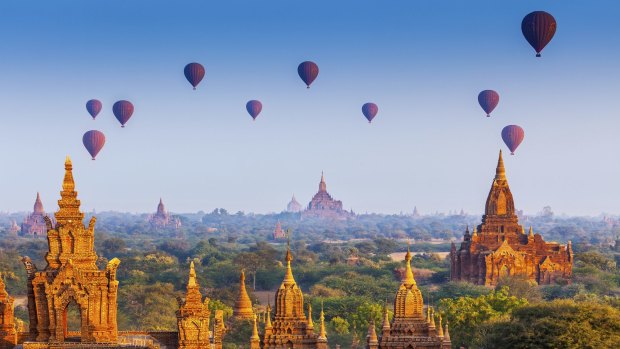
Balloons fly above temples in Bagan, Myanmar. Credit: iStock
As the shapes of ancient Bagan emerge from the darkness, a dozen passengers file off the Cruiseco Explorer. It's too early for the hawkers usually waiting for us but there is just enough light to pick our way over the soft silt of the Irrawaddy's riverbank, climb a set of makeshift steel steps and hoist ourselves onto the waiting vintage bus. The driver, perched on a crude wooden seat, tussles with the floor gearstick and sets off for a distant field.
Australian Brett Melzer and his Yangon-born wife, Khin Omar Win, pioneered Bagan's hot-air ballooning industry when they started Balloons over Bagan with a single balloon in 1999. We arrive to find a row of the company's magenta balloons laid out on the ground like empty sausage skins. As giant fans force air into them, they rise from the ground strewn with prickles, scrub and dry-as-bone grass. Tea and coffee are set up on camp tables. It's a nice idea but the consequences could be uncomfortable once air-borne.
We're assigned to Mike Petteford, who has piloted hot-air balloons across the deserts of central Australia, the tablelands of Far North Queensland and the migration paths of the Masai Mara in east Africa. He got into hot-air ballooning when his father bought a hot-air balloon to advertise his coal-merchant business in Bristol, England. "I've grown up with it," he says. In 2011, Petteford was part of a record-setting, 50-strong hot-air balloon crossing of the English Channel.
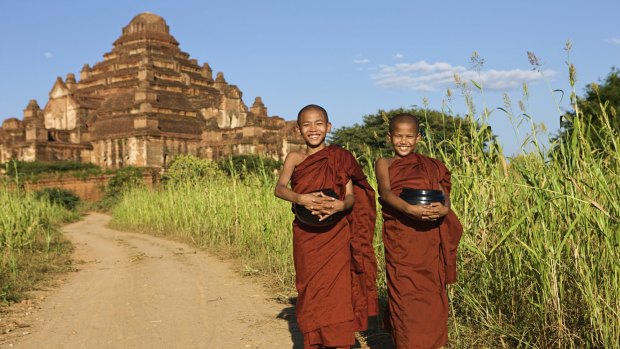
Two young Buddhist monks in Bagan.Credit: Bartosz Hadyniak
Once airborne, Petteford enthuses about Bagan's ballooning conditions. "This place is phenomenal for its low breezes," he says. "We're the only aviators who use them." On this particular morning, two days from the end of balloon season, the breeze is blowing at two miles an hour near the ground and at seven miles an hour higher up. The layers of wind push us past more than 2500 Buddhist monuments built between the 10th and 14th centuries that stud the plain below and make Bagan a photographer's paradise. A massive earthquake struck the area in 1975, reducing many temples and pagodas to rubble. Restoration work began immediately, but the efforts have been criticised.
Bagan sits in Myanmar's central dry zone where rainfall is rare from December to April. Yet visibility from our perch is better than expected. Petteford rotates the basket to give us a bird's-eye view of red-brick temples and other balloons dotting the sky.
Some of my fellow passengers were nervous about heights before climbing into the wicker basket but all is calm once we're aloft. "This is the safest form of aviation by far," says Petteford. "If you want to get scared look straight down – but if you're looking across [the landscape] it's very, very different."
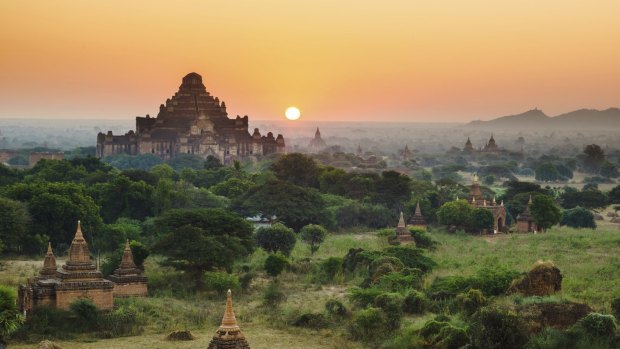
The Temples of Bagan at sunrise. Credit: LKUNL
I look straight down because, as the sun rises, there's so much ground activity to observe. We're close enough to wave to families breakfasting on the ground. They wave back. I spot a flash of blue – a kingfisher landing in one of the acacias – and someone else sees a squirrel darting up a tree. Dogs chase each other and pelt through the fields. We see a hotel pool of turquoise and joke that we wouldn't mind being dropped off there. Despite the hour and our elevation, it's warm enough not to need long sleeves.
Our landing field in New Bagan looms too soon. We sit, tuck away cameras and anything else that could hit us in the face, and brace for landing. We've been prepped for a possible tip-over but instead we hover at a 45-degree angle once we connect with the ground. Will we? Won't we? When the basket is righted, we stand and cheer. In England, where labour is more expensive, Petteford and his passengers would pack up the balloon. But here in Myanmar, where labour is cheap, there's a crew of a dozen who do that for us.
We head to a little table holding celebratory champagne, banana cake and fruit. Bagan's hawkers have descended too, arriving on motorbikes the second we touch down. "Shopping time!" announces one cheerfully, holding aloft pairs of print trousers. It's only 7am; he doesn't make any sales.
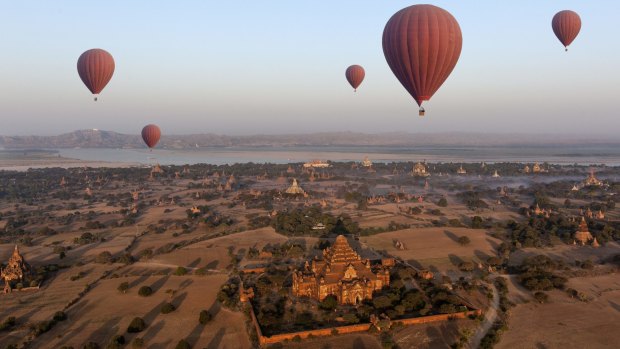
Balloons fly over Dhammayangyi Temple, with the Irrawaddy River in the background.Credit: Steve Allen
Petteford raises his glass to toast the flight. "Here we don't say cheers - we say cha kwar," he says. "Cha kwar," we echo, still giddy even though our feet are back on solid ground.
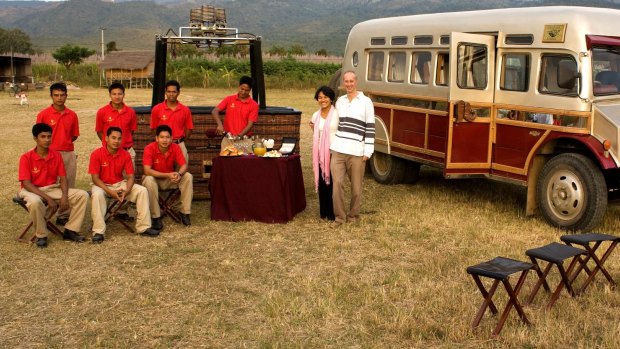
Australian Brett Melzer and his Yangon-born wife, Khin Omar Win, pioneered Bagan's hot-air ballooning industry. Credit: Balloons Over Bagan
Bagan's hot-air balloon season runs from early October to the end of March. Balloons over Bagan's 45-minute classic balloon flight starts from $400 a person. See balloonsoverbagan.com; cruising.com.au.
The writer travelled to Myanmar courtesy of Cruiseco; the balloon ride was at her own expense.
Sign up for the Traveller Deals newsletter
Get exclusive travel deals delivered straight to your inbox. Sign up now.